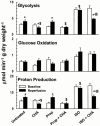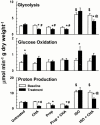Influence of beta-adrenoceptor tone on the cardioprotective efficacy of adenosine A(1) receptor activation in isolated working rat hearts
- PMID: 11015305
- PMCID: PMC1572354
- DOI: 10.1038/sj.bjp.0703597
Influence of beta-adrenoceptor tone on the cardioprotective efficacy of adenosine A(1) receptor activation in isolated working rat hearts
Abstract
This study investigated the role of beta-adrenoceptors in the cardioprotective and metabolic actions of adenosine A(1) receptor stimulation. Isolated paced (300 beats min(-1)) working rat hearts were perfused with Krebs-Henseleit solution containing 1.2 mM palmitate. Left ventricular minute work (LV work), O(2) consumption and rates of glycolysis and glucose oxidation were measured during reperfusion (30 min) following global ischaemia (30 min) as well as during aerobic conditions. Relative to untreated hearts, N(6)-cyclohexyladenosine (CHA, 0.5 microM) improved post-ischaemic LV work (158%) and reduced glycolysis and proton production (53 and 42%, respectively). CHA+propranolol (1 microM) had similar beneficial effects, while propranolol alone did not affect post-ischaemic LV work or glucose metabolism. Isoprenaline (10 nM) impaired post-ischaemic function and after 25 min ischaemia recovery was comparable with 30 min ischaemia in untreated hearts (41 and 53%, respectively). Relative to isoprenaline alone, CHA+isoprenaline improved recovery of LV work (181%) and reduced glycolysis and proton production (64 and 60%, respectively). In aerobic hearts, CHA, propranolol or CHA+propranolol had no effect on LV work or glucose oxidation. Glycolysis was inhibited by CHA, propranolol and CHA+propranolol (50, 53 and 52%, respectively). Isoprenaline-induced increases in heart rate, glycolysis and proton production were attenuated by CHA (85, 57 and 53%, respectively). The cardioprotective efficacy of CHA was unaffected by antagonism or activation of beta-adrenoceptors. Thus, the mechanism of protection by adenosine A(1) receptor activation does not involve functional antagonism of beta-adrenoceptors.
Figures




Similar articles
-
K(ATP)-channel activation: effects on myocardial recovery from ischaemia and role in the cardioprotective response to adenosine A1-receptor stimulation.Br J Pharmacol. 1998 Jun;124(4):639-46. doi: 10.1038/sj.bjp.0701872. Br J Pharmacol. 1998. PMID: 9690854 Free PMC article.
-
Alteration of glycogen and glucose metabolism in ischaemic and post-ischaemic working rat hearts by adenosine A1 receptor stimulation.Br J Pharmacol. 1999 Sep;128(1):197-205. doi: 10.1038/sj.bjp.0702765. Br J Pharmacol. 1999. PMID: 10498852 Free PMC article.
-
Inhibition of glycolysis and enhanced mechanical function of working rat hearts as a result of adenosine A1 receptor stimulation during reperfusion following ischaemia.Br J Pharmacol. 1996 May;118(2):355-63. doi: 10.1111/j.1476-5381.1996.tb15410.x. Br J Pharmacol. 1996. PMID: 8735638 Free PMC article.
-
Phentolamine prevents the adverse effects of adenosine on glycolysis and mechanical function in isolated working rat hearts subjected to antecedent ischemia.J Mol Cell Cardiol. 2000 Jun;32(6):1075-86. doi: 10.1006/jmcc.2000.1144. J Mol Cell Cardiol. 2000. PMID: 10888259
-
Antecedent ischemia reverses effects of adenosine on glycolysis and mechanical function of working hearts.Am J Physiol. 1996 Nov;271(5 Pt 2):H2116-25. doi: 10.1152/ajpheart.1996.271.5.H2116. Am J Physiol. 1996. PMID: 8945932
References
-
- BOLLI R., MARBAN E. Molecular and cellular mechanisms of myocardial stunning. Physiol. Rev. 1999;79:609–634. - PubMed
-
- COLLINS-NAKAI R.L., NOSEWORTHY D., LOPASCHUK G.D. Epinephrine increases ATP production in hearts by preferentially increasing glucose metabolism. Am. J. Physiol. 1994;267:H1862–H1871. - PubMed
-
- COLLIS M.G. The vasodilator role of adenosine. Pharmacol. Ther. 1989;41:143–162. - PubMed
-
- DENNIS S.C., GEVERS W., OPIE L.H. Protons in ischemia: where do they come from; where do they go to. J. Mol. Cell. Cardiol. 1991;23:1077–1086. - PubMed
-
- DOBSON J.G.J., ORDWAY R.W., FENTON R.A. Endogenous adenosine inhibits catecholamine contractile responses in normoxic hearts. Am. J. Physiol. 1986;251:H455–H462. - PubMed
Publication types
MeSH terms
Substances
LinkOut - more resources
Full Text Sources
Miscellaneous

